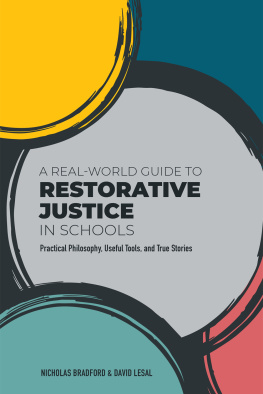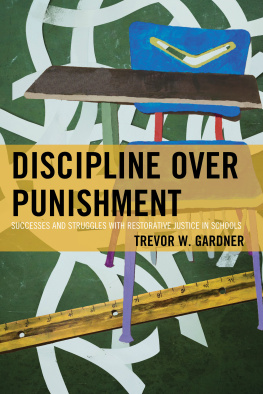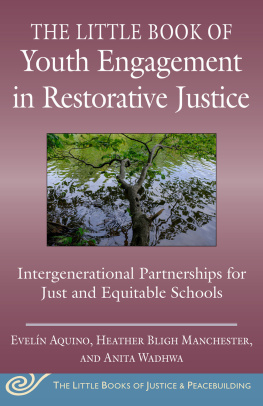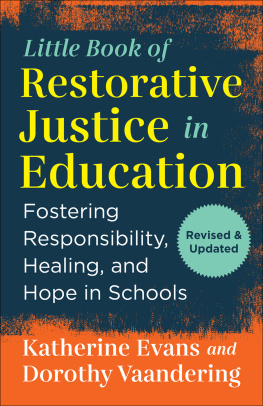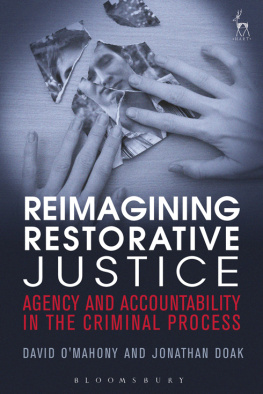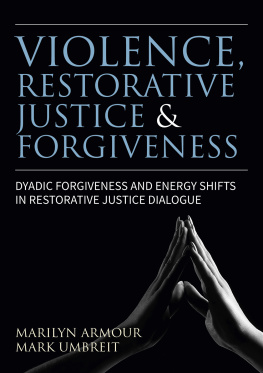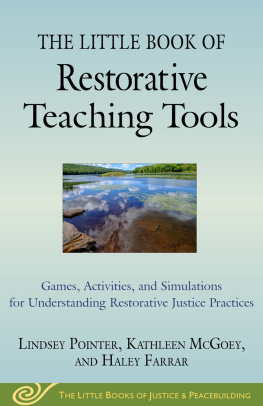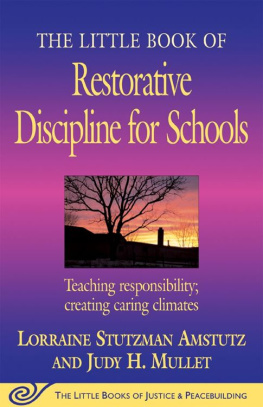Restorative
Justice Today
This book is dedicated to Audrey Sutherland, Ellen Langer, and the late Insoo Kim Berg, whose collective wisdom and courage to do what seemed impossible inspires us to believe justice can be restorative. Audrey swam around the North Shore of Molokai alone in 1962 at the age of 40; Ellen challenges us to invent our lives and world not merely discover things; and Insoo taught us to change our language to change our lives, and to help others who want to change theirs.
Restorative
Justice Today
Practical Applications
Katherine S. van Wormer
University of Northern Iowa
Lorenn Walker
University of Hawaii Honolulu Community College
Editors
FOR INFORMATION:
SAGE Publications, Inc.
2455 Teller Road
Thousand Oaks, California 91320
E-mail:
SAGE Publications Ltd.
1 Olivers Yard
55 City Road
London EC1Y 1SP
United Kingdom
SAGE Publications India Pvt. Ltd.
B 1/I 1 Mohan Cooperative Industrial Area
Mathura Road, New Delhi 110 044
India
SAGE Publications Asia-Pacific Pte. Ltd.
3 Church Street
#10-04 Samsung Hub
Singapore 049483
Acquisitions Editor: Jerry Westby
Production Editor: Brittany Bauhaus
Copy Editor: Dan Gordon
Typesetter: C&M Digitals (P) Ltd.
Proofreader: Carole Quandt
Cover Designer: Anupama Krishnan
Marketing Manager: Terra Schultz
Permissions Editor: Karen Ehrmann
Copyright 2013 by SAGE Publications, Inc.
All rights reserved. No part of this book may be reproduced or utilized in any form or by any means, electronic or mechanical, including photocopying, recording, or by any information storage and retrieval system, without permission in writing from the publisher.
Printed in the United States of America
Library of Congress Cataloging-in-Publication Data
Restorative justice today: practical applications / editors, Katherine S. van Wormer, Lorenn Walker.
p. cm.
Includes bibliographical references and index.
ISBN 978-1-4522-1991-2 (pbk.)
1. Restorative justice. 2. Justice, Administration of.
I. Van Wormer, Katherine S. II. Walker, Lorenn.
HV8688.R496 2013
364.68dc23 2012017347
This book is printed on acid-free paper.
12 13 14 15 16 10 9 8 7 6 5 4 3 2 1
Brief Contents
Shadd Maruna
Lorenn Walker
Kay Pranis
Rudi Kauffman and Heather Koontz
David Wexler
Lorenn Walker
Margaret Thorsborne
Dennis S.W. Wong
Ida Hydle
Lorenn Walker
Gale Burford
Ted Wachtel and Stacey Miller
Gabrielle Maxwell
Mona Schatz
Anne Hayden and Katherine van Wormer
Theo Gavrielides
Amy Holloway and Gale Burford
Lorenn Walker, Andrew Johnson, and Katherine van Wormer
Lorenn Walker and Ted Sakai
Lorenn Walker and Rebecca Greening
Lorenn Walker
Carl Stauffer
David K. Androff
Marta Vides Saade
Rita Takahashi
Fred H. Besthorn
Detailed Contents
Shadd Maruna
Lorenn Walker
Kay Pranis
Rudi Kauffman and Heather Koontz
David Wexler
Lorenn Walker
Margaret Thorsborne
Dennis S.W. Wong
Ida Hydle
Lorenn Walker
Gale Burford
Ted Wachtel and Stacey Miller
Gabrielle Maxwell
Mona Schatz
Anne Hayden and Katherine van Wormer
Theo Gavrielides
Amy Holloway and Gale Burford
Lorenn Walker, Andrew Johnson, and Katherine van Wormer
Lorenn Walker and Ted Sakai
Lorenn Walker and Rebecca Greening
Lorenn Walker
Carl Stauffer
David K. Androff
Marta Vides Saade
Rita Takahashi
Fred H. Besthorn
Foreword
C riminologys love affair with restorative justice is now in its third decade, and it has been interesting to watch that love develop. Plato and the ancient Greeks famously distinguished between different types of love, differentiating eros (or the swooning sense of being in love) with agape, the deeper sense of true love one feels for a life companion after many years. Certainly, our feelings for restorative justice have developed in this sense over the years.
We have passed through the puppy love and infatuation stage, endlessly scribbling its name inside heart shapes: Crim Loves RJ, Crim loves RJ at conferences and meetings. Such crushes quickly wane and can become a source of embarrassment and denial in retrospect. It is hard for any object of worship to live up to the expectations and imagination of the most smitten, so former devotees can turn quickly into denigrators. Indeed, there have even been hard times in the past few decades between criminology and restorative justice. We have fought and struggled and even discussed parting ways. We saw the relationship through those hard times, however, and we even formalized the relationship (made it legit). In the past few decades, restorative justice has gone from being a pie-in-the-sky revolution to being the subject of increasingly tedious academic conferences, textbooks, and journals to ultimately becoming part of the bureaucratic machinery of numerous criminal justice systems around the world. The first books on restorative justice had titles like Changing Lenses; newer books have titles like Institutionalizing Restorative Justice. Yes, our relationship has gotten very serious indeed.
It is hard, of course, not to miss those early days with all of their radical hopes and dreams. We shared a vision for remaking justice as we knew it; it was hard not to get caught up in the excitement of it all. The restorative justice movement today feels less dangerous, less daunting, less dramatic, and less fun. We have moved from beautiful ideas to reality and seen the restorative justice alternative for what it is, warts and all. The movement has suffered missteps, attracted charlatans and con artists, and proven itself to be all too human, like any other social movement fueled and driven by, well, we humans. I understand and sympathize with those of my colleagues who have abandoned the movement and decided to look for another beautiful idea to come around, sweep them off their feet, and rekindle the giddiness of eros and excitement.
Yet, the love that those of us still in the movement feel now is still very much real; it is just a more mature, more nuanced, and tempered affection. We see the limitations and shortcomings of the restorative framework, we know it is not perfect, but we continue to be deeply impressed by its wisdom and grace. It may no longer be trendy and cutting edge, but it has survived by proving instead to be timeless, based on ancient principles that accord with hard-wired human intuitions about fairness and morality.
This collection of new empirical and theoretical essays, put together by two of the most interesting thinkers (and doers) in the restorative movement, reflects that wisdom and demonstrates why restorative justice is still an idea to be reckoned withmaybe the idea to be reckoned within justice debates. The ideas herein may no longer make us swoon with eros, but will strengthen and reaffirm the feelings of agape that so many of us have come to feel about restorative justice over these many years. Youll love it.


